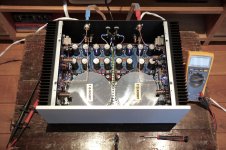Well, here I go...
I haven't visited these forums for several years, but I've accumulated the parts for an F6 and if I can muster my few remaining brain cells, I'm embarking on my first amp build beyond a few gainclones and a Bottlehead kit.
Wish me luck if you will...
.7
I haven't visited these forums for several years, but I've accumulated the parts for an F6 and if I can muster my few remaining brain cells, I'm embarking on my first amp build beyond a few gainclones and a Bottlehead kit.
Wish me luck if you will...
.7
but I've accumulated the parts for an F6 and if I can muster my few remaining brain cells,
.7
No one is dumber than me.
🙂
Haha.. Dude, Pleased to make your acquaintance... I'll be the one asking questions tho. 🙂
Cheers,
d
Cheers,
d
I was just set to buy a couple of Fluke Meters and now another option!!!
Can anyone advise a non-electronics based mindset which Fluke meters are best for building and testing the Pass Amps?
And, recommend any of the Kiethley DMM's to buy instead of the Fluke if this is a better option?
Two Flukes or one Kiethley to start the new lab I'm being 'forced' to build as well as any info on the new oscilloscopes that may be best.
Thanks,
P { margin-bottom: 0.08in; } Holzarbeiter
If you just want to measure dc offset and bias just buy cheap multimeters and with the money saved buy a nice quality lab power supply with 2 x bipolar outputs with current limiting adjustment.
After that get an oscilloscope and signal generator.
After that upgrade to better quality multimeters. You can still use the cheap ones for most things.
After that a distortion analyzer.
Maybe over a 5 year period. Just a bit at a time.
What is everyone using for bias values on the F6? 0.5v or higher? How much were you able to achieve before hitting one of the 3 bias limits, notably 65c on transistor pin 2?
For bias of 1.3AWhat is everyone using for bias values on the F6? 0.5v or higher? How much were you able to achieve before hitting one of the 3 bias limits, notably 65c on transistor pin 2?
1.3 x 0.47 or
1.3 x 0.56
At those levels on suitable sized heatsink. You shouldn't have any issue.
So 1.3A is the ideal bias?
I am using 0.47 (as per build guide), so I should raise from 0.5V to 0.611V?
I am using 0.47 (as per build guide), so I should raise from 0.5V to 0.611V?
1.3A is a good compromise and is generally what Nelson uses with 23V to 24 rails.So 1.3A is the ideal bias?
I am using 0.47 (as per build guide), so I should raise from 0.5V to 0.611V?
What heatsinks do you have?
Assuming your heatsinks are the right size then yes raise to 0.611
Thanks. Am using the hifi2000 4U case.
No problem.
Raise to 1.3A (0.611V)
5 minutes into the first listening on my newly built F6.
MIND = BLOWN
Hehehe.
🙂
Internal speaker cable looks a touch thin but then again with your speakers you'll probably never exceed 1A.
It is Amtrans OFC gold plated wire, 0.9mm dia, with PFA sleeving (19 AWG). Line in is 0.4mm (26 AWG).
According to this website 19awg will be fine for chassis wiring for your current requirements. Surprising what they consider max current rating is for 19awg chassis wiring.
I generally wouldn't use anything thinner than 16awg for the speaker or power supply wiring.
American Wire Gauge table and AWG Electrical Current Load Limits with skin depth frequencies and wire breaking strength
I generally wouldn't use anything thinner than 16awg for the speaker or power supply wiring.
American Wire Gauge table and AWG Electrical Current Load Limits with skin depth frequencies and wire breaking strength
glued to my seat. I owned a DartZeel 108 about 2 years, this F6 is giving me the same kind of finesse. I have yet to boost the bias from 1 to 1.3A, and caps are not close to being broken in. I am noticing the bias drifting around quite a bit, I guess this is due to the whole starving 9.1V zener diode discussion...
- Home
- Amplifiers
- Pass Labs
- The diyAudio Firstwatt F6
